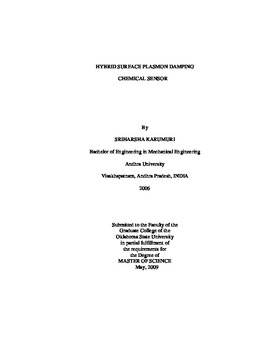| dc.contributor.advisor | Kalkan, A. Kaan | |
| dc.contributor.author | Karumuri Spiharsha | |
| dc.date.accessioned | 2014-04-17T19:52:40Z | |
| dc.date.available | 2014-04-17T19:52:40Z | |
| dc.date.issued | 2009-05-01 | |
| dc.identifier.uri | https://hdl.handle.net/11244/9958 | |
| dc.description.abstract | The present thesis work demonstrates a novel localized surface plasmon resonance (LSPR) chemical sensor on the basis of a unique sensing mechanism: adsorbate-induced damping of hybrid plasmon resonance. The sensor reports the width (damping factor) and intensity of the hybrid plasmon resonance associated with a monolayer of silver nanoparticles. These two parameters, continuously measured by optical extinction, are substituted in a theoretical relation (derived in the present work) to quantify the number of electrons gained or lost (by the plasmon) due to the adsorbed molecules or atoms. The change in the number of free electrons precisely equals the number of adsorbates. The plasmonic nanostructures are silver nanoparticle monolayers fabricated by electroless reduction of Ag+ on Si thin films. The nanoparticle monolayers are exposed to a short annealing step to reduce the hybrid plasmon damping by close to a factor of 2. This dramatic reduction in intrinsic damping leads to a substantial enhancement in sensitivity, since now the contribution of adsorbate-induced damping to total damping is more pronounced. The sensor response has been explored using mercury as the detection agent. Detection of ppb levels of Hg has been accomplished. Further, the sensor is found to be capable of resolving multiple Hg Langmuir adsorption isotherms. These different adsorption isotherms are likely to be associated with different crystalline directions (i.e., facets) on the nanoparticle surfaces. Interestingly, the isotherms are found to start at different times. Also surprising is that, sensor response indicates dissociation of N2 on Ag nanoparticles and a chemical reaction between Ag, N, and Hg. As to the origin of damping reduction by the aforementioned annealing step, light scattering measurements reveal that the radiative damping factor reduces to 35% of its original value. | |
| dc.format | application/pdf | |
| dc.language | en_US | |
| dc.publisher | Oklahoma State University | |
| dc.rights | Copyright is held by the author who has granted the Oklahoma State University Library the non-exclusive right to share this material in its institutional repository. Contact Digital Library Services at lib-dls@okstate.edu or 405-744-9161 for the permission policy on the use, reproduction or distribution of this material. | |
| dc.title | Hybrid Surface Plasmon Damping Chemical Sensor | |
| dc.type | text | |
| dc.contributor.committeeMember | Singh, Raman P. | |
| dc.contributor.committeeMember | Lavine, Barry K. | |
| osu.filename | Karumuri_okstate_0664M_10156.pdf | |
| osu.college | Engineering, Architecture, and Technology | |
| osu.accesstype | Open Access | |
| dc.description.department | Mechanical & Aerospace Engineering | |
| dc.type.genre | Thesis | |
